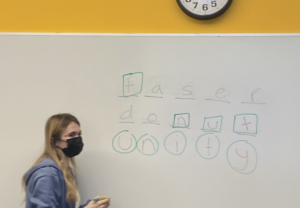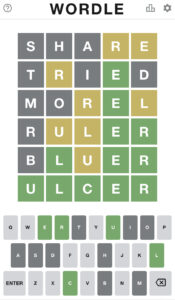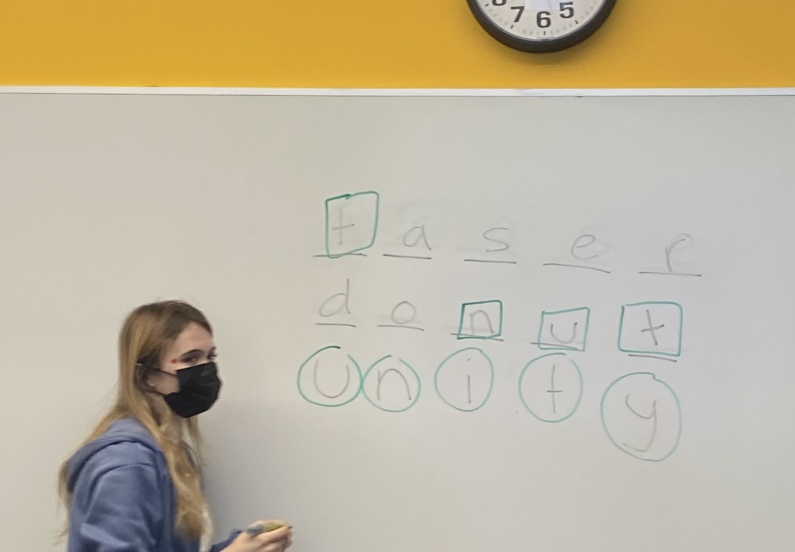
photo by Naomi Taxay
Wordle, a Mastermind-style word game that recently became the internet’s latest craze, has been rising in popularity among Lick-Wilmerding students. The game, created by Josh Wardle, took over the campus in less than a month, inspiring conversation of vocabulary, strategy, score sharing and even student’s own versions scribbled on whiteboards.
The gameplay is simple. Every day the website has a new five-letter word for players to guess in up to six attempts. The word-of-the-day is the same for all players, similar to the New York Times’ Daily Crossword. After a word is guessed, the website assigns each letter in the word a color to let users know if they are on the right path.
Green means the letter is correct and in the correct space, yellow means the letter is in the word but in a different spot and gray means the letter is not in the word. A player’s score is determined by the number of guesses it takes them to guess the correct word, and the website keeps track of a player’s statistics from day to day.

photo courtesy of Naomi Taxay
The game is addictive, and because users can only play once a day, it draws in a hankering, devoted audience.
At LWHS, halls are bustling with talk of the game. “The Center is packed with people sharing their scores and others trying to finish the game before someone spoils the word for them,” said Kreeya Makan ’23.
Sharing scores is one of the reasons the game went viral. The website lets users share their wins without revealing the word, through a grid of gray, yellow and green emoji boxes that can be sent easily through text or social media.
Rhea Verghese ’23 said that the game is a bonding activity for her family. “Every single morning my mom, my sister and I play it, and we have a group chat where we send our grids,” she said.
The grids, combined with everyone having the same word each day, give people a common struggle. In some ways, the word-of-the-day is like an inside joke all users share, which is one reason the game gained so much traction.
Another reason the game became popular was because of its deceiving simplicity. It is a fun game with easy-to-understand rules, but the game also utilizes linguistics and a user’s intuitive understanding of the English language.
A player’s first guess in Wordle is completely random, and many people use the first word that comes to mind. But for some players, the game is actually more about mathematics than vocabulary, and they employ strategies and statistics to maximize their success.
For the first word, Zoe Yang ’23 uses the strategy of never repeating letters. That way, she can get the most information out of each guess. “My mom always starts with the word ‘adieu,’” she explained. “It has most of the vowels which helps eliminate a lot of words.”
What sets Wordle apart from other games with similar gameplay, which exist in different capacities across the internet, is its feel of lightness and existence purely for joy. It is not out to get players addicted to their phone (after all, users can only play once a day), and it is not driven by some other malicious attempt to make money. It creates something positive for users and the public really sees that.
In a short time frame, the game went from obscurity to something played by entire families. From November 2021 to January 2022, daily users jumped from less than a hundred to 10 million.
Wordle was never meant to get as much fame as it did. The website’s creator, Josh Wardle, originally made the game solely for his partner, Palak Shah. He named the game Wordle as wordplay with his own last name and put up the website that would cost him $100 a month to keep online. Wardle does not make money off of the game and has never included advertisements.
Wardle told Times Magazine that making money off the game never appealed to him. “The goal was to make a game that my partner would enjoy playing,” he said. Monetization was never his intention.
Wardle’s newfound fame caught him off guard and he was quickly overwhelmed by it. When the New York Times offered to buy the game from him, he accepted. Announced through their Twitter account on January 31, the New York Times made the purchase for a price “in the low seven figures.”
The purchase has upset many admirers of the game’s original pureness and independence. While the New York Times has expressed that the game will initially remain free, it is quite possible that the game will become only accessible to those with a New York Times game’s subscription.
History teacher Marley Pierce is a big fan of Wordle and has played it with her classes. She feels like it makes sense that the New York Times would buy Wordle, especially since they are trying to increase digital membership. “I just hope it remains free and that there’s only one a day,” she said. “That’s probably the most special thing about it.”
Pierce has noticed the game’s popularity at LWHS and is really happy that students are getting excited about word games. “Wordle has led students to try out the crossword and other word games with their friends. It’s been really positive for the community,” she said.






